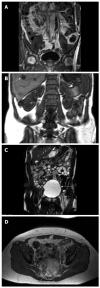Incidental findings at MRI-enterography in patients with suspected or known Crohn's disease
- PMID: 20039452
- PMCID: PMC2799920
- DOI: 10.3748/wjg.v16.i1.76
Incidental findings at MRI-enterography in patients with suspected or known Crohn's disease
Abstract
Aim: To determine the frequency and clinical impact of incidental findings detected with magnetic resonance imaging (MRI)-enterography in patients with suspected or known Crohn's disease (CD).
Methods: Incidental findings were defined as unexpected lesions outside the small intestine, not previously known or suspected at the time of referral, and not related to inflammatory bowel disease. Through a systematic review of medical charts we analyzed the clinical impact of incidental findings, and compared the MRI findings with subsequent diagnostic procedures.
Results: A total of 283 patients were included in the analysis, and MRI detected active CD in 31%, fistula in 1.4% and abscess in 0.7%. Extra-intestinal findings not related to CD were recorded in 72 patients (25%), of which 58 patients (20%) had 74 previously unknown lesions. Important or incompletely characterized findings were detected in 17 patients (6.0%). Incidental findings led to 12 further interventions in 9 patients (3.2%) revealing previously unknown pathological conditions in 5 (1.8%). One patient (0.4%) underwent surgery and one patient was diagnosed with a malignant disease. MRI detected incidental colonic lesions in 16 patients of which additional work-up in 4 revealed normal anatomy. Two patients (0.7%) benefitted from the additional examinations, whereas incidental findings led to unnecessary examinations in 9 (3.2%).
Conclusion: In a minority of patients with suspected or known CD, important incidental findings are diagnosed at MRI-enterography. However, a substantial number of patients experience unnecessary morbidity because of additional examinations of benign or normal conditions.
Figures

Similar articles
-
Magnetic resonance enterography in Crohn's disease: a comparison with the findings at surgery.Colorectal Dis. 2013;15(10):1273-80. doi: 10.1111/codi.12361. Colorectal Dis. 2013. PMID: 23869486
-
[Value of contrast-enhanced MR enterography in pediatric Crohn's disease: preliminary study].J Radiol. 2005 Nov;86(11):1685-92. doi: 10.1016/s0221-0363(05)81508-2. J Radiol. 2005. PMID: 16269980 French.
-
Accuracy of CT enterography and magnetic resonance enterography imaging to detect lesions preoperatively in patients undergoing surgery for Crohn's disease.Dis Colon Rectum. 2014 Dec;57(12):1364-70. doi: 10.1097/DCR.0000000000000244. Dis Colon Rectum. 2014. PMID: 25380001
-
Magnetic resonance enterography in Crohn's disease: a guide to common imaging manifestations for the IBD physician.J Crohns Colitis. 2013 Sep;7(8):603-15. doi: 10.1016/j.crohns.2012.10.005. Epub 2012 Nov 1. J Crohns Colitis. 2013. PMID: 23122965 Review.
-
Unusual intestinal and extra intestinal findings in Crohn's disease seen on abdominal computed tomography and magnetic resonance enterography.Clin Imaging. 2020 Jan;59(1):30-38. doi: 10.1016/j.clinimag.2019.04.010. Epub 2019 Apr 24. Clin Imaging. 2020. PMID: 31715515 Review.
Cited by
-
Magnetic resonance imaging and spectroscopy: how useful is it for prediction and prognosis?EPMA J. 2011 Dec;2(4):403-10. doi: 10.1007/s13167-011-0086-x. Epub 2011 May 25. EPMA J. 2011. PMID: 23199177 Free PMC article.
-
Prevalence and clinical significance of incidental extra-intestinal findings in MR enterography: experience of a single University Centre.Radiol Med. 2021 Feb;126(2):181-188. doi: 10.1007/s11547-020-01235-6. Epub 2020 Jun 3. Radiol Med. 2021. PMID: 32495273
-
MR enterography versus capsule endoscopy in paediatric patients with suspected Crohn's disease.Eur Radiol. 2011 Apr;21(4):823-31. doi: 10.1007/s00330-010-1976-3. Epub 2010 Oct 5. Eur Radiol. 2011. PMID: 20922391
-
Unexpected Findings in Magnetic Resonance Enterography and Their Clinical Significance.Can J Gastroenterol Hepatol. 2016;2016:4020569. doi: 10.1155/2016/4020569. Epub 2016 Mar 29. Can J Gastroenterol Hepatol. 2016. PMID: 27446837 Free PMC article.
-
MRI enterography: what is the clinical impact of unsuspected extra-enteric findings?Br J Radiol. 2012 Sep;85(1017):e766-9. doi: 10.1259/bjr/33344438. Epub 2012 May 2. Br J Radiol. 2012. PMID: 22553300 Free PMC article.
References
-
- Masselli G, Casciani E, Polettini E, Gualdi G. Comparison of MR enteroclysis with MR enterography and conventional enteroclysis in patients with Crohn’s disease. Eur Radiol. 2008;18:438–447. - PubMed
-
- Negaard A, Paulsen V, Sandvik L, Berstad AE, Borthne A, Try K, Lygren I, Storaas T, Klow NE. A prospective randomized comparison between two MRI studies of the small bowel in Crohn’s disease, the oral contrast method and MR enteroclysis. Eur Radiol. 2007;17:2294–2301. - PubMed
-
- Schreyer AG, Geissler A, Albrich H, Schölmerich J, Feuerbach S, Rogler G, Völk M, Herfarth H. Abdominal MRI after enteroclysis or with oral contrast in patients with suspected or proven Crohn’s disease. Clin Gastroenterol Hepatol. 2004;2:491–497. - PubMed
-
- Masselli G, Casciani E, Polettini E, Lanciotti S, Bertini L, Gualdi G. Assessment of Crohn’s disease in the small bowel: Prospective comparison of magnetic resonance enteroclysis with conventional enteroclysis. Eur Radiol. 2006;16:2817–2827. - PubMed
-
- Gourtsoyiannis NC, Grammatikakis J, Papamastorakis G, Koutroumbakis J, Prassopoulos P, Rousomoustakaki M, Papanikolaou N. Imaging of small intestinal Crohn’s disease: comparison between MR enteroclysis and conventional enteroclysis. Eur Radiol. 2006;16:1915–1925. - PubMed
MeSH terms
LinkOut - more resources
Full Text Sources
Medical

